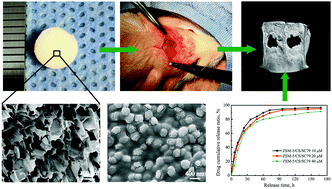SC79-loaded ZSM-5/chitosan porous scaffolds with enhanced stem cell osteogenic differentiation and bone regeneration
Abstract
For effectively treating bone defects, the design of novel therapeutic scaffolds is an important strategy for enhancing stem cell osteogenic differentiation and new bone formation. Herein, we, for the first time, fabricated SC79-loaded ZSM-5/chitosan (ZSM-5/CS/SC79) porous scaffolds via the freeze-drying synthesis of ZSM-5/CS porous scaffolds followed by loading SC79 drug molecules. The ZSM-5/CS scaffolds possessed a three-dimensional (3D) interconnected porous structure, and the nanostructured ZSM-5 ellipsoids were uniformly dispersed on the CS films. The ZSM-5/CS/SC79 scaffolds had appropriate drug loading-release properties due to the hierarchically porous structures of ZSM-5 zeolites and the hydrogen bonding between the CS and SC97. In vitro cell tests demonstrated that both the ZSM-5/CS and ZSM-5/CS/SC79 scaffolds could promote the adhesion, spreading and proliferation of human bone mesenchymal stem cells (hBMSCs). Interestingly, the SC97 released from the scaffolds not only promoted the proliferation of hBMSCs, but also enhanced the osteogenic differentiation. As compared with the ZSM-5/CS control group, the ZSM-5/CS/SC79 scaffolds promoted the ALP activity of hBMSCs, improved the mRNA relative expression levels of osteocalcin (OCN), bone morphogenetic protein-2 (BMP-2) and alkaline phosphatise (ALP), and increased the protein level of β-catenin. The enhanced proliferation and osteogenic differentiation of hBMSCs contributed to the upregulation of Akt kinase by an activated Wnt/β-catenin signaling pathway. Moreover, in vivo animal tests indicated that SC79 released from the ZSM-5/CS/SC79 scaffolds promoted the new bone regeneration without systemic side effects in cranial defects. Therefore, ZSM-5/CS/SC79 scaffolds as novel and promising therapeutic scaffolds have promising applications in defined local bone regeneration.



 Please wait while we load your content...
Please wait while we load your content...